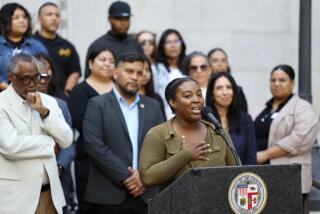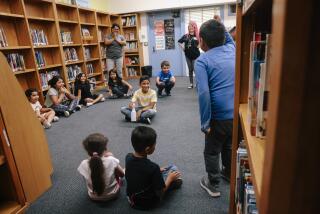Teen-Age Moms Turn to Peers : Program Is Successful but Critics Call Stipend a Reward for Morality
SAN MATEO — Mary Sanders was 13 when she got pregnant and just 14 when her son, Michael, was born in the middle of her freshman year at Woodside High School. Her best friend, a 13-year-old neighbor, held her hand during labor and delivery.
Her mother, a single parent herself, was not happy that Mary had short-circuited plans for finishing high school and going on to college. The baby’s father, 17 years old, was hardly in the picture at all.
These were the circumstances under which Mary Sanders, nearly a child herself, became responsible for the infant, Michael Sanders.
Statistically, the deck was stacked against both of them. Children born to physically and emotionally immature mothers are at higher risk for health problems and learning difficulties. They are more likely to be victims of abuse or neglect. They are almost certain to live in poverty.
Mary’s story, though, may turn out differently. She will start her senior year at Woodside next fall, and plans to go on to college. Michael, now 2, is healthy and developmentally on target for his age.
His mother has found a balance between school, motherhood and family that she says would have been impossible without a support group for teen-age mothers known as the dollar-a-day program.
Modeled on a similar, successful program in Colorado, the California version was begun a year ago by Planned Parenthood of San Mateo County. Twelve young mothers meet weekly with a group leader to discuss their children and to learn about nutrition, contraception, child abuse, relationships with parents and boyfriends and other issues. At each meeting, the girls are given $10 for staying in the program and avoiding pregnancy.
This last aspect has become a sticking point with some. Assemblyman Bruce Bronzan (D-Fresno) says he has been “beaten over the head” with it as a result of his sponsorship of legislation that would expand the San Mateo County program to three more sites in the state. The bill passed the Assembly and is scheduled to be heard in the Senate Health and Human Services Committee on Wednesday.
Opponents say the stipend sends the wrong message to girls who have already gone wrong, bribing them to observe morality.
Bronzan calls it a misunderstanding of the program’s intent.
“The stipend has almost nothing to do with it,” he said. “It’s just to get them to come to the meeting, which is where the real magic occurs. These are mostly kids who come from broken homes where there is no positive role model and no encouragement to them as individuals. If the girls cannot see themselves as worthwhile, if they cannot see a positive future, they have little incentive. The peer group fills a void in their lives and tells them, ‘Yes, you are important. You can have a future and you can make that future.’ ”
In 1985, nearly 500,000 babies were born to teen-age mothers, according to the latest figures of the Allan Guttmacher Institute, a nonprofit think tank specializing in child, family and reproductive issues. California’s problem was found to be particularly acute that year. It ranked first among the states in the rate of teen-age pregnancy and abortion, and was 17th highest in the rate of births to teen-agers.
Using peer support to help teen-agers cope with motherhood while they struggle to mature themselves is not a new concept.
It was pioneered 17 years ago in Minnesota as a way of intervening in the cycle of child abuse, which is all too common in very young parents. Known by the acronym MELD, Minnesota’s “Young Moms” program has been replicated throughout the United States and in Canada, Australia and West Germany, according to Joni Pitcl of Friends of the Family in Van Nuys, which this summer will launch the first Young Moms program in Southern California.
The program has been shown to reduce the incidence of child abuse and neglect from 40% of children of teen-age mothers to 10% among those who participate in the program. In addition, 80% of participants finish high school, compared to 20% in the general population; only 20% have another pregnancy during their teens, compared to 50%, and 70% become self-supporting compared to 20% of those without such a program, Pitcl said.
“It gives them the time and support to find their inner resources and grow into their new role,” she said.
While the Young Moms program does not pay cash to attract the girls, there is a comparable incentive. At the end of each meeting, the girls are given a “gift,” Pitcl says, perhaps diapers for the baby and bubble bath for the mother. Like those who defend the dollar-a-day concept, advocates describe the gift-giving as a gesture of caring.
In Colorado, the gesture turned into cash when it began its peer support programs for teen-age mothers five years ago.
Colorado’s is a true dollar-a-day program, with each girl receiving seven one-dollar bills at the end of each meeting. San Mateo’s pays $10 a week. Those proposed by Bronzan would pay $5 a week.
The pilot project in San Mateo County is only half way through the two-year program. But already there are signs of success, according to Toni Guy, a Planned Parenthood community educator who leads one of two groups. None of the girls, who range in age from 16 to 19, is pregnant again, and none have dropped out of high school.
“All of them have made some changes in their opinions of themselves, in their parenting skills, in the way they care for themselves,” Guy said.
For Mary Sanders, Tuesday night “group” has become the high point of her week, so much so that she was upset when Guy called her last October on the evening of the Bay Area earthquake to cancel the meeting.
“I don’t come just because of the money,” Mary said. “I come because it is people to talk to and people to work out problems with. If I was having a problem with my mother or there was something I couldn’t talk to her about, I could talk to the group. I can talk about how to deal with guys and other things because there’s older girls there.”
Mary says she has learned how to recognize illness in her son, how to discipline him and what to expect from him at different ages. She likes the fact that Michael gets to play with other toddlers during the meetings, because he has little contact with children his age. And Mary says she learns a lot by comparing Michael’s behavior and skills with those of the other children.
Mary had little of that support during her pregnancy. She knew she was pregnant when she missed a menstrual period. But afraid to tell her mother, she started on a lonely journey that for many pregnant teen-agers, experts say, leads to even greater isolation once they give birth.
“She wanted me to go to college because she got married right out of high school and had my sister and didn’t have a chance,” Mary said. Mother and daughter also had never talked about boys and sex because, says Mary, “I was so young and she didn’t think I was doing anything.”
So Mary confided in her 13-year old neighbor, who queried her own mother in order to give Mary advice on how to care for herself. In this way, Mary learned to avoid junk food and protect her health. She did not smoke. She tried to get enough rest.
“I knew I wasn’t ready for a baby, but when I felt him moving, I didn’t want to give him up,” Mary says.
Her mother did not learn about the pregnancy until it was nearly six months along. Mary had confided in a cousin. The cousin told her mother, who told Mary’s mother.
“She was mad because I didn’t come to her sooner,” Mary says of her mother’s reaction. “She wanted me to get medical attention.”
Michael was born in January of Mary’s freshman year at Woodside. A month later, with her mother as baby-sitter, Mary returned to school. Shortly afterward, a school nurse told her about Planned Parenthood’s teen-age mothers program. Mary signed up.
“I don’t want another child, not right now, at least,” Mary said. “Maybe in six or seven years when I have a job and a home and transportation, because when you have a child, you need transportation. I want to get an education. I don’t want to be a bag woman or something like that because I can’t get a job. I want to go to a community college because I don’t want to be away from home and Michael. Then I want to work with computers because I want to be able to support Michael.”
As for the $10 Mary makes going to the meetings, most of it ends up in the cash register at Lucky’s supermarket. Mary heads there right after the meetings. She searches out the store’s Lady Lee brand of diapers because it’s the cheapest--just a little over $9.
More to Read
Sign up for Essential California
The most important California stories and recommendations in your inbox every morning.
You may occasionally receive promotional content from the Los Angeles Times.










